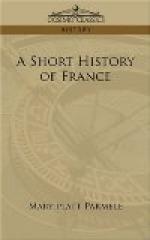As was to be expected, it was in the cities that this half-emancipated class congregated; these cities as naturally becoming the centres of the various industries required to supply the necessities and luxuries of the two ruling classes. In this way there were being created various centres of wealth, which meant power, and which would have to be reckoned with in the future.
The thin edge of the wedge was inserted when individual freemen offered money to their hard-pressed feudal lords in exchange for certain privileges, and then for charters. And as more money was needed by proprietors for their lavish expenditures, more freedom and more charters were acquired, until, having purchased immunities and privileges enough to make them to some extent self-governing, the town became what was called a commune.
It was Louis VI., fifth king in the Capetian line, who completed this work of emancipation by recognizing the communes as free cities, and bestowing franchises clearly defining their rights. By this act the body of the manufacturing class, or burgesses, was recognized as a part of the body politic, and was enfranchised.
A free city was a small republic. The entire body of inhabitants must take the communal oath, and when summoned by the tolling of the bell must all appear at the meeting of the General Assembly for the purpose of choosing their magistrates. This done, the assembly dissolved, and the magistrates were left with a free hand to rule or ruin, until checked by popular outbreak or a new election.
As is always the case, time developed two classes: an inferior population, with a furious spirit of democracy, and a superior class, more conservative, and desirous of keeping peace with the great proprietors.
In this simple, humble fashion were the people groping toward freedom, and experimenting with the alphabet of self-government.
The acknowledgment of the free cities by Louis VI., was the first move toward an alliance between the king and the people; an alliance which would eventually wrest the power from the hands of the nobles. But that end was still far off. Another accession to the kingly power came in the succeeding reign when Louis VII. married Eleanor, daughter of the Duke of Aquitaine; and her great inheritance, the largest of the feudal states, was thereby annexed to the crown: a marriage which made some troublesome chapters in the history of two kingdoms, of which we shall hear later. But, in the duel between king and peerage, the balance of power was moving toward the throne.
At the time these things were happening that great event, the Crusades, had already commenced.




